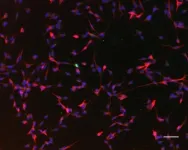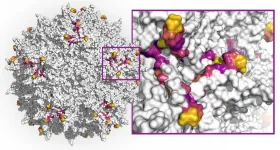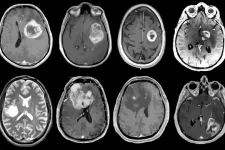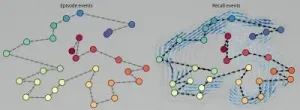(Press-News.org) Cambridge, MA - February 11, 2020 - Dyno Therapeutics, a biotech company applying artificial intelligence (AI) to gene therapy, today announced a publication in Nature Biotechnology that demonstrates the use of artificial intelligence to generate an unprecedented diversity of adeno-associated virus (AAV) capsids towards identifying functional variants capable of evading the immune system, a factor that is critical to enabling all patients to benefit from gene therapies. The research was conducted in collaboration with Google Research, Harvard's Wyss Institute for Biologically Inspired Engineering and the Harvard Medical School laboratory of George M. Church, Ph.D., a Dyno scientific co-founder. The publication is entitled "Deep diversification of an AAV capsid protein by machine learning."
It is estimated that up to 50-70% of the human population have pre-existing immunity to natural forms of the AAV vectors currently being using to deliver gene therapies. This immunity renders a large portion of patients ineligible to receive gene therapies which rely upon these capsids as the vector for delivery. Overcoming the challenge of pre-existing immunity to AAV vectors is therefore a major goal for the gene therapy field.
"The approach described in the Nature Biotechnology paper opens a radically new frontier in capsid design. Our study clearly demonstrates the potential of machine learning to guide the design of diverse and functional sequence variants, far beyond what exists in nature," said Eric Kelsic, Ph.D., Dyno's CEO and co-founder. "We continue to expand and apply the power of artificial intelligence to design vectors that can not only overcome the problem of pre-existing immunity but also address the need for more effective and selective tissue targeting. At Dyno, we are making rapid progress to design novel AAV vectors that overcome the limitations of current vectors, improving treatments for more patients and expanding the number of diseases treatable with gene therapies."
The Nature Biotechnology paper describes the rapid production of a large library of distinct AAV capsid variants designed by machine learning models. Nearly 60% of the variants produced were determined to be viable, a significant increase over the typical yield of END
Artificial intelligence generates new diversity of AAV capsids for broader gene therapy
Approach rapidly generates the functional diversity needed to evade neutralization by the immune system, allowing more patients to benefit from gene therapies
2021-02-11
ELSE PRESS RELEASES FROM THIS DATE:
Compounds from apples may boost brain function
2021-02-11
Natural compounds found in apples and other fruits may help stimulate the production of new brain cells, which may have implications for learning and memory, according to a END ...
Machine-learning how to create better AAV gene delivery vehicles
2021-02-11
(Boston) -- Adeno-associated viruses (AAVs) have become promising vehicles for delivering gene therapies to defective tissues in the human body because they are non-pathogenic and can transfer therapeutic DNA into target cells. However, while the first gene therapy products approved by the Federal Drug Administration (FDA) use AAV vectors and others are likely to follow, AAV vectors still have not reached their full potential to meet gene therapeutic challenges.
First, currently used AAV capsids - the spherical protein structures enveloping the virus' single-stranded DNA genome which can be modified to encode therapeutic genes - are limited in their ability to specifically hone in on the tissue affected by a disease and their wider distribution throughout ...
Aggressive brain tumor mapped in genetic, molecular detail
2021-02-11
Glioblastoma is among the most aggressive and devastating of cancers. While rare compared with other cancers, it's the most common type of brain cancer. Even with intensive therapy, relatively few patients survive longer than two years after diagnosis, and fewer than 10% of patients survive beyond five years. Despite extensive studies focused on genomic features of glioblastoma, relatively little progress has been made in improving treatment for patients with this deadly disease.
Now, a new study led by Washington University School of Medicine in St. Louis, Pacific Northwest National Laboratory, Case Western Reserve University and the National Cancer Institute (NCI) of the National Institutes of Health (NIH) has revealed a detailed map of the genes, ...
SARS-CoV-2 screening using CRISPR-based methods
2021-02-11
What The Study Did: This observational study assessed CRISPR-based methods for screening to detect SARS-CoV-2 among asymptomatic college students.
Authors: Carolina Arias, Ph.D., of the University of California, Santa Barbara, is the corresponding author.
To access the embargoed study: Visit our For The Media website at this link https://media.jamanetwork.com/
(doi:10.1001/jamanetworkopen.2020.37129)
Editor's Note: The article includes funding/support disclosures. Please see the article for additional information, including other authors, author contributions and affiliations, conflict of interest and financial disclosures, and funding and support.
INFORMATION:
Media advisory: ...
National trends in us otolaryngology surgical volume early in COVID-19 pandemic
2021-02-11
What The Study Did: Changes in otolaryngology surgical volumes in the United States early on in the COVID-19 pandemic are described in this study.
Authors: Anirudh Saraswathula, M.D., M.S., of Johns Hopkins University School of Medicine in Baltimore, is the corresponding author.
To access the embargoed study: Visit our For The Media website at this link https://media.jamanetwork.com/
(doi:10.1001/jamaoto.2020.5472)
Editor's Note: Please see the article for additional information, including other authors, author contributions and affiliations, conflict of interest ...
Pragmatic solutions to counteract regressive effects of COVID-19 pandemic for women in academic oncology
2021-02-11
What The Viewpoint Says: How pandemic-related disruptions may adversely impact progress toward a gender-balanced workforce in academic oncology is described in this article, which also offers possible solutions to mitigate the problem in this specialty.
Authors: Reshma Jagsi, M.D., D.Phil., of the University of Michigan in Ann Arbor, is the corresponding author.
To access the embargoed study: Visit our For The Media website at this link https://media.jamanetwork.com/
(doi:10.1001/jamaoncol.2020.7681)
Editor's Note: The article includes conflicts of interest disclosures. Please see the article for additional information, including other authors, author contributions and affiliations, conflict of interest and financial disclosures, and funding and support.
INFORMATION:
Media ...
How do our memories take shape?
2021-02-11
Your brain is constantly evaluating which aspects of your experiences to either remember for later, ignore, or forget. Dartmouth researchers have developed a new approach for studying these aspects of memory, by creating a computer program that turns sequences of events from a video into unique geometric shapes. These shapes can then be compared to the shapes of how people recounted the events. The study provides new insight into how experiences are committed to memory and recounted to others. The results are published in Nature Human Behavior and were based on how people remembered the experience of watching an episode of Sherlock, a BBC television show.
"When we represent experiences and memories as shapes, we can use the tools ...
Study identifies never-before-seen dual function in enzyme critical for cancer growth
2021-02-11
Considered the most lethal form of DNA damage, double-strand breaks must be repaired to prevent cell death. In developing therapies for hard-to-treat breast and ovarian cancers in patients with BRCA gene mutations, scientists aim to identify ways to keep cancer cells from using DNA break repair pathways. New findings demonstrate a previously-unknown capability for polymerase theta (pol theta) - a key enzyme in this repair function - that shows promise as a new avenue for treatment development.
The study results are published in Molecular Cell.
Researchers at the University of Vermont (UVM), The University of Texas MD Anderson ...
Protected areas see continued deforestation but at a reduced rate, OSU research shows
2021-02-11
CORVALLIS, Ore. - A survey of more than 18,000 land parcels spanning 2 million square miles across 63 countries shows that a "protected area" designation reduces the rate of deforestation but does not prevent it.
Published today in Nature Ecology and Evolution, the findings are important because most terrestrial species live in forests and because the study suggests that just 6.5% of the Earth's woodlands are truly protected, well below the 2020 target of 17% set by the United Nations' Convention on Biological Diversity.
The findings are also timely given President Biden's recent executive order on climate change, which calls for protecting 30% of the United States' ...
Vaporised crusts of Earth-like planets found in dying stars
2021-02-11
Observations of lithium and potassium around white dwarf stars point to remains of rocky planet crusts
Analysis by astronomers led by University of Warwick shows chemical composition of crusts is very similar to Earth's continental crust
The outer layers of the white dwarfs contain up to 300,000 gigatonnes of rocky debris, which includes up to 60 gigatonnes of lithium and 3,000 gigatonnes of potassium
These white dwarfs are among the oldest stars in our galaxy, and could host one of the oldest planetary systems discovered so far
Remnants of planets with Earth-like crusts have been discovered in the atmospheres of four nearby white dwarf stars by University of Warwick astronomers, offering a glimpse of the planets that may have once orbited ...
LAST 30 PRESS RELEASES:
Ecology: Mummified cheetahs discovery gives hope for species’ Arabic reintroduction
Researchers survey the ADHD coaching boom
Air pollution and cardiac remodeling and function in patients with breast cancer
Risk of suicide in patients with traumatic injuries
Post–intensive care syndrome
The lifesaving potential of opioid abatement funds
The Frontiers of Knowledge Award goes to Allan MacDonald and Pablo Jarillo-Herrero for their discovery of the “magic angle” enabling science to transform and control the behavior of new materials
Discovery reveals how keto diet can prevent seizures when drugs fail
JMIR Publications and Sikt announce pilot flat-fee unlimited open access partnership
Finding new cell markers to track the most aggressive breast cancer in blood
A new, cleaner way to make this common fertilizer
Fire-safe all-solid-state batteries move closer to commercialization
Disinfecting drinking water produces potentially toxic byproducts — new AI model is helping to identify them
Unplanned cesarean deliveries linked to higher risk of acute psychological stress after childbirth
Healthy aging 2026: fresh pork in plant-forward diets supported strength and brain-health biomarkers in older adults
Scientists identify pre-cancerous states in seemingly normal aging tissues
Itaconate modifications: mechanisms and applications
Potential tumor-suppressing gene identified in pancreatic cancer
Winners of the 2026 Hill Prizes announced
Autonomous AI agents developed to detect early signs of cognitive decline
Study finds ocean impacts nearly double economic cost of climate change
Increased deciduous tree dominance reduces wildfire carbon losses in boreal forests
Researchers discover how a respiratory bacterium obtains essential lipids from the human body and targets fat-rich tissues
Locust swarms destroy crops. Scientists found a way to stop that
More resources and collaboration needed to support prevention and treatment of obesity
Two types of underconfidence linked to anxiety and gender
Insects are victims too: Global study shows impacts of invasive alien species on populations
Pioneering natural, degradable polymer capsules
Forestry is becoming digital and automated
Maternity baby deaths much higher in northern England than in the South
[Press-News.org] Artificial intelligence generates new diversity of AAV capsids for broader gene therapyApproach rapidly generates the functional diversity needed to evade neutralization by the immune system, allowing more patients to benefit from gene therapies





